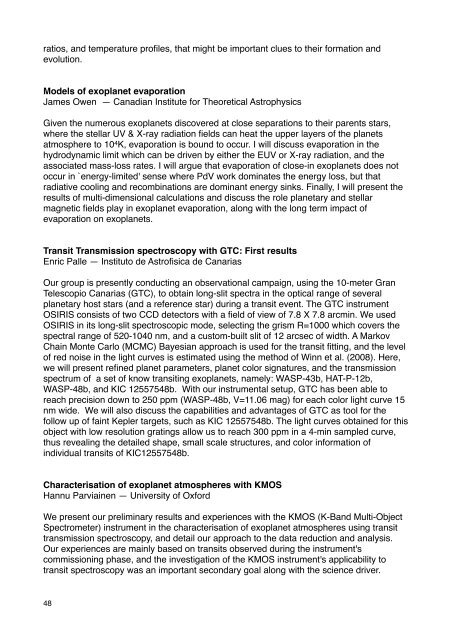Exoclimes_Conference_booklet1
Exoclimes_Conference_booklet1
Exoclimes_Conference_booklet1
Create successful ePaper yourself
Turn your PDF publications into a flip-book with our unique Google optimized e-Paper software.
atios, and temperature profiles, that might be important clues to their formation and<br />
evolution.<br />
Models of exoplanet evaporation<br />
James! Owen — Canadian Institute for Theoretical Astrophysics<br />
Given the numerous exoplanets discovered at close separations to their parents stars,<br />
where the stellar UV & X-ray radiation fields can heat the upper layers of the planets<br />
atmosphere to 10 4 K, evaporation is bound to occur. I will discuss evaporation in the<br />
hydrodynamic limit which can be driven by either the EUV or X-ray radiation, and the<br />
associated mass-loss rates. I will argue that evaporation of close-in exoplanets does not<br />
occur in `energy-limited' sense where PdV work dominates the energy loss, but that<br />
radiative cooling and recombinations are dominant energy sinks. Finally, I will present the<br />
results of multi-dimensional calculations and discuss the role planetary and stellar<br />
magnetic fields play in exoplanet evaporation, along with the long term impact of<br />
evaporation on exoplanets.<br />
Transit Transmission spectroscopy with GTC: First results<br />
Enric Palle — Instituto de Astrofisica de Canarias<br />
Our group is presently conducting an observational campaign, using the 10-meter Gran<br />
Telescopio Canarias (GTC), to obtain long-slit spectra in the optical range of several<br />
planetary host stars (and a reference star) during a transit event. The GTC instrument<br />
OSIRIS consists of two CCD detectors with a field of view of 7.8 X 7.8 arcmin. We used<br />
OSIRIS in its long-slit spectroscopic mode, selecting the grism R=1000 which covers the<br />
spectral range of 520-1040 nm, and a custom-built slit of 12 arcsec of width. A Markov<br />
Chain Monte Carlo (MCMC) Bayesian approach is used for the transit fitting, and the level<br />
of red noise in the light curves is estimated using the method of Winn et al. (2008). Here,<br />
we will present refined planet parameters, planet color signatures, and the transmission<br />
spectrum of a set of know transiting exoplanets, namely: WASP-43b, HAT-P-12b,<br />
WASP-48b, and KIC 12557548b. With our instrumental setup, GTC has been able to<br />
reach precision down to 250 ppm (WASP-48b, V=11.06 mag) for each color light curve 15<br />
nm wide. We will also discuss the capabilities and advantages of GTC as tool for the<br />
follow up of faint Kepler targets, such as KIC 12557548b. The light curves obtained for this<br />
object with low resolution gratings allow us to reach 300 ppm in a 4-min sampled curve,<br />
thus revealing the detailed shape, small scale structures, and color information of<br />
individual transits of KIC12557548b.<br />
Characterisation of exoplanet atmospheres with KMOS<br />
Hannu Parviainen — University of Oxford<br />
We present our preliminary results and experiences with the KMOS (K-Band Multi-Object<br />
Spectrometer) instrument in the characterisation of exoplanet atmospheres using transit<br />
transmission spectroscopy, and detail our approach to the data reduction and analysis.<br />
Our experiences are mainly based on transits observed during the instrument's<br />
commissioning phase, and the investigation of the KMOS instrument's applicability to<br />
transit spectroscopy was an important secondary goal along with the science driver.<br />
48


